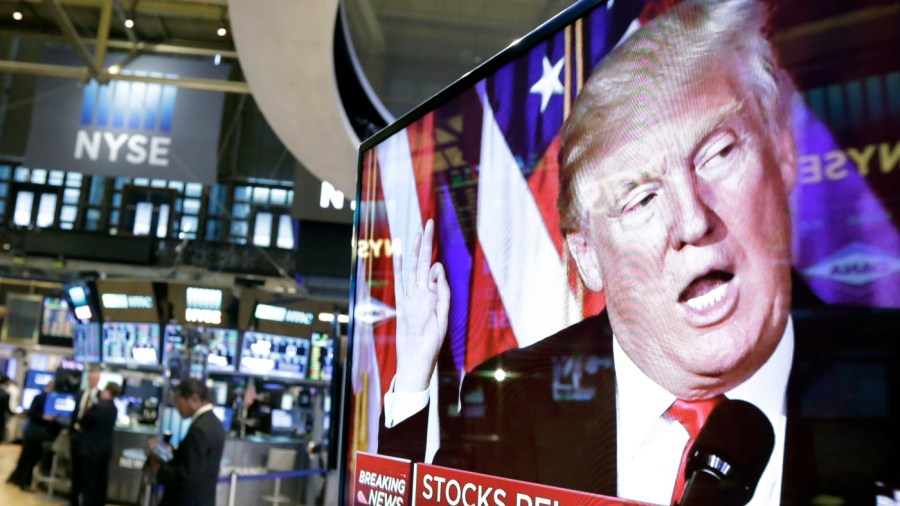
Donald Trump winning the popular vote and control of Congress was not the only shocker this week; the stock market response was almost as stunning.
On Nov. 6, the day after the former president was declared the winner over Vice President Kamala Harris, stocks posted their best post-election day ever. Shares hit all-time highs and the dollar made its biggest one-day advance since 2022. The S&P 500 jumped 2.5 percent, while the Russell Index of small-cap companies rose almost 6 percent.
In addition, the volatility-measuring VIX index, also called Wall Street’s “fear gauge,” plummeted, and the number of shares traded soared to 19 billion — 63 percent above the average daily trading volume of the last 90 days, according to Bloomberg. The rally was an astonishing endorsement of the president-elect.
But wait — didn’t 23 Nobel Prize-winning economists declare Harris’s economic plan “vastly superior” to that of Trump? Didn’t 400 economists and former policy-makers endorse her agenda and her “vision for the U.S. economy?”
And wasn’t the media clear that investors wanted a divided government, because that would likely constrain what left-wing pundits were calling Trump’s “worst impulses”?
Is it possible that media soothsayers laid out purposefully negative scenarios describing the risks of the Trump agenda, just to sway voters? (Hint: That was a rhetorical question.)
Here’s what got very little press during the election: Harris’s proposed $5 trillion tax hike. Or what about the extent to which Biden-Harris regulation is disrupting U.S. corporations? Or the reality that Trump’s policies in his first term provided growth with low inflation and low unemployment? Pre-COVID, that happy combination was produced without a huge boost in government spending. Pre-COVID, as the former president might say, the economy was a thing of beauty.
What can we expect this time around? President-elect Trump has laid out plans to continue the pro-growth agenda of his first term. As opposed to Harris’s program, which would have hiked the tax rate on businesses to 28 percent, Trump wants to drop the rate to as low as 15 percent for companies that produce in the U.S. In his first term, Trump worked with Congress to reduce the corporate tax to 21 percent, in line with this year’s average among OECD countries, from 35 percent. Now, Trump wants to provide U.S. firms an even greater competitive advantage and prod them to produce at home.
Lower taxes on businesses means more investment, more innovation, higher productivity and higher wages. It means growth.
Trump is also keen to reduce regulations. Without much notice from the media, the Biden-Harris White House has presided over a tsunami of consequential regulation, surpassing the levels of prior presidents going back 40 years. They have implemented vast numbers of new rules, many of which overturned Trump policies, like those reinstituting tough fuel efficiency standards for vehicles.
The good news is that, using the rarely used Congressional Review Act, Trump will have the opportunity to overturn much of the stifling Biden-Harris agenda. In his first two years in office last time round, Trump reversed 16 major rules initiated by President Obama, accounting for 80 percent of the times any president has taken advantage of that opportunity.
Trump inherits an economy held aloft by out-of-control federal spending. It soared late in his own term as bipartisan bills passed by Congress attempted to keep the pandemic-era economy afloat. The sin, though, was that the Biden-Harris White House continued to promote above-trend spending even after the economy had roared back to life, thus boosting inflation. Federal outlays have been running at 23 to 24 percent of GDP, versus an historic average closer to 21 percent; nearly everyone agrees that spending must come down.
Trump’s camp will face increasing pressure to cut spending. Trump has proposed partnering with Elon Musk to create a Government Efficiency Commission, tasked with tackling the waste and fraud buried in our $6 trillion federal budget. How that effort will pay off remains to be seen, but for those skeptical that presidents can wage war on their own overstuffed bureaucracies, I commend to you the recent history of Argentina. President Javier Milei campaigned with a chain saw, promising to slash the country’s dangerous spending and bureaucracy; defying nay-sayers, Argentina is on track for zero deficit this year, and inflation has plummeted to 3.5 percent from 25 percent. It can be done.
There is no question that Trump will use tariffs, or the threat of tariffs, to improve our trade balance with other nations and boost domestic manufacturing. The utility of such levies is undeniable in trying to level the playing field with aggressive exporters. That is why the Biden-Harris White House maintained Trump’s tariffs on Chinese goods.
It is also why the European Union recently adopted its first-ever tariffs on Chinese autos imported into the region; European car companies are being crushed by cheap Chinese electric vehicles. VW recently announced it would be closing three plants in Germany — the first in its history. It was a dark reminder of what could happen in Detroit.
Trump will train his tariffs on China, which continues to evade trade rules, but may extend the levies to other countries with a substantial trade imbalance with the U.S. The countries other than China with the biggest goods trade surpluses into the U.S. include the EU, Mexico, Vietnam and Japan. Our negotiations with Mexico will likely focus on a trade-off between border help and trade. Trump has promised to stanch the flow of people entering the country illegally across our southern border. To do that he will need Mexico’s help.
Trump has achieved an historic win; he will have two years (at least) to execute on his growth plan. Voters will hope he does just that.
Liz Peek is a former partner of major bracket Wall Street firm Wertheim and Company.

